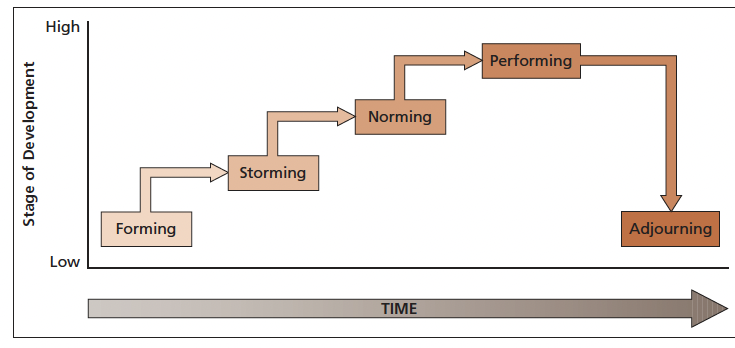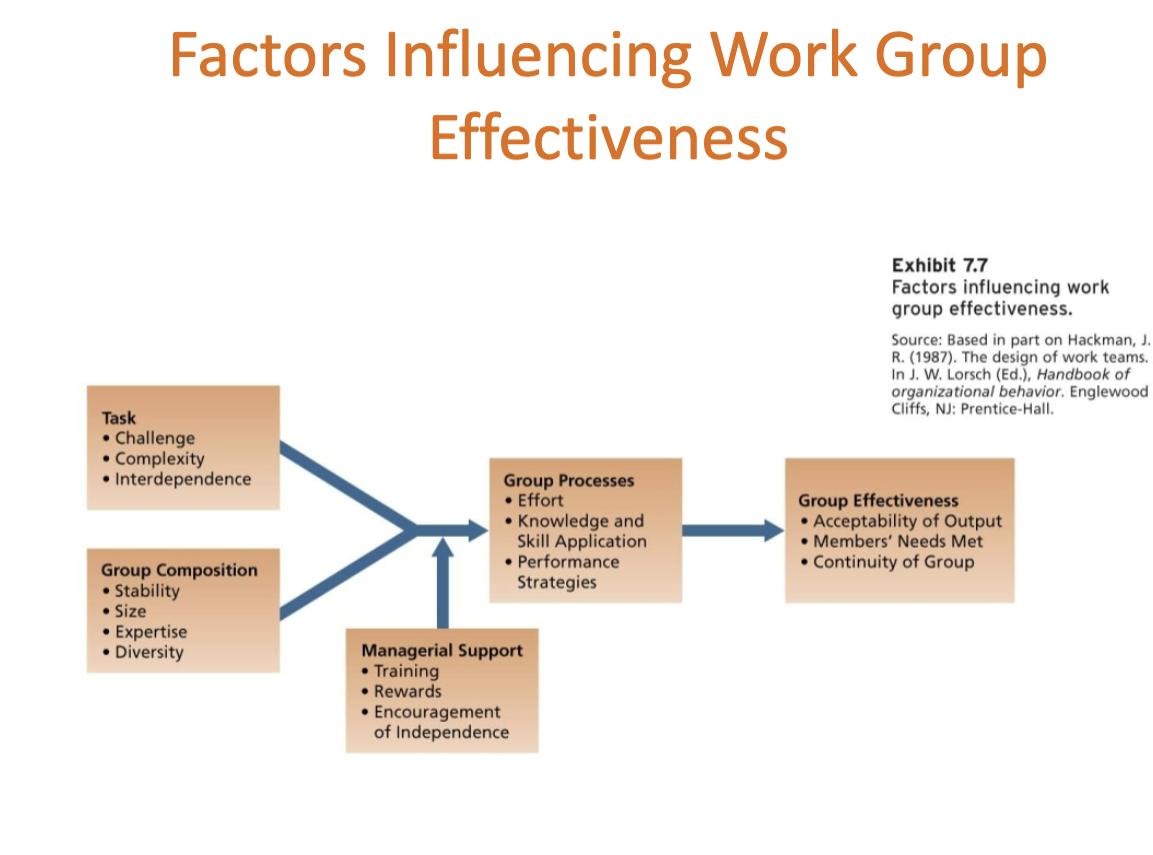OB- chapter 7 Groups +Teamwork
1/20
There's no tags or description
Looks like no tags are added yet.
Name | Mastery | Learn | Test | Matching | Spaced |
|---|
No study sessions yet.
21 Terms
Formal work group
Groups that are established by organizations to facilitate the achievement of organizational goals
ex. A marketing team at a company formed to develop and launch a new product campaign. Each member has assigned roles, deadlines, and responsibilities.
Informal group
Groups that form naturally among employees based on shared interests, friendships, or social needs, rather than organizational structure.
ex. A group of coworkers who regularly eat lunch together and discuss common interests like sports or weekend plans, helping to boost morale and social support.
Group development
Forming
The first stage where group members get to know each other, explore the group’s purpose, and figure out how to fit in. There's uncertainty and dependency on leadership.
ex. A newly formed project team at a consulting firm meets for the first time to discuss their goals and share backgrounds, but everyone is still polite and cautious.
Storming
The second stage marked by conflict as members assert opinions, challenge roles, and test boundaries. Tension and disagreement are common.
ex. Members of a sales strategy group disagree on how to divide responsibilities, leading to arguments and clashes over leadership and priorities.
Norming
the group resolves conflicts, establishes norms and roles, and develops stronger cohesion. Collaboration improves.
ex. After early conflicts, a software development team agrees on a shared coding process and starts supporting each other's ideas more openly.
Performing
The group is now fully functional, focusing on achieving goals with high efficiency, trust, and teamwork.
ex. A marketing team in the performing stage is creating a successful ad campaign, brainstorming creatively, and meeting tight deadlines with minimal conflict.
Adjourning
The final stage where the group disbands after achieving its goals. Emotional reflection and closure are common.
ex. A task force that successfully launched a new product celebrates their success with a team dinner before moving on to different assignments

Punctuated Equilibrium Model
A model of group development for teams with deadlines, showing how group activity alternates between long periods of stability and short bursts of change — especially at the first meeting, midpoint, and end of the timeline.
ex. : A student group with a 4-week deadline for a presentation shows little progress in the first two weeks, suddenly restructures their approach at the midpoint, and then works intensely to finish the project.
Phase 1
Begins right after the first meeting, which sets the tone and direction.
Group works steadily but shows little visible progress.
Early assumptions and routines dominate this stage.
Example: A student group plans a slideshow format early on and sticks to just researching for the first 2 weeks of a 4-week project.
2. Midpoint Transition
Happens at the exact halfway point of the deadline.
Marks a turning point: group reflects, reassesses, and often makes major changes.
Urgency increases; strategy usually shifts.
Example: At week 2 of a 4-week deadline, the group realizes the slideshow format is weak, so they switch to a video approach and reassign tasks.
3. Phase 2
Group executes the revised plan with increased focus and urgency.
Ends with a burst of activity and concern over final evaluation.
Example: The group rapidly produces the video, practices the presentation, and finalizes details before the deadline.
Additive Tasks
Tasks where the group’s performance is based on the sum of individual efforts.
ex. A sales team where each member contributes to the overall sales quota. The more each person sells, the better the team does.
Disjunctive Tasks
tasks where the group’s performance depends on the best-performing member.
ex. A problem-solving team where one member figures out the correct solution and the group adopts it.
Conjunctive Tasks
Tasks where the group’s performance is limited by the weakest member’s performance.
ex An assembly line where the slowest worker delays the entire process.
Process Losses
Performance issues that arise from motivational or coordination problems, especially in larger groups.
ex. A team project where tasks are unevenly divided or people slack off because they assume others will pick up the slack (social loafing).
Diversity of group
Diverse groups take longer to communicate and become cohesive (forming, storming, norming phases).
Once established, diverse and less diverse groups are equally cohesive and productive.
Diversity boosts performance on complex, creative, and problem-solving tasks.
Negative effects of surface diversity (age, gender, race) usually fade over time with more interaction.
Norms
Collective expectations that members of social units have regarding the behaviour of each other
ex. dress norms, reward allocation norms, prefromance norms
Roles
Uncertainty or lack of clarity about job goals, responsibilities, or how to perform tasks
Assigned roles: Officially designated roles given to members (e.g., team leader, secretary).
Emergent roles: Roles that develop naturally over time based on group dynamics (e.g., informal mediator, jokester).
Role conflict
Intrasender Role Conflict
Occurs when one role sender (like a boss or supervisor) gives conflicting expectations to a person in a role.
Example: Your manager asks you to complete two tasks that cannot be done simultaneously.
Intersender Role Conflict
Happens when two or more role senders provide incompatible expectations.
Example: Your manager wants you to focus on speed, but the quality control team insists on thoroughness, causing conflict.
Interrole Conflict
Arises when a person holds multiple roles that have incompatible expectations.
Example: You are both a team leader at work and a parent at home, and the demands from both roles clash.
Person–Role Conflict
Occurs when role demands clash with the person’s own personality, values, or skills.
Example: You’re asked to be very assertive in your role, but you are naturally reserved and uncomfortable with confrontation
Status
Definition: Rank or prestige given to group members based on how they’re evaluated.
Systems: Can be formal (titles, roles) or informal (popularity, respect).
Effects:
People talk more with those of equal or higher status.
Higher-status members speak more and influence decisions.
Reducing Barriers:
Organizations may remove status symbols to improve communication.
Group Cohesiveness
Threat & Competition:
External threats or competition increase group unity as members work together to face challenges.
(e.g., companies uniting during a takeover attempt).Success:
Groups that succeed become more attractive to members. Failure usually lowers cohesiveness, unless shared struggle bonds the group.Member Diversity:
Diverse groups may struggle with cohesiveness at first, but shared goals and success can override differences.Group Size:
Smaller groups are usually more cohesive. Larger groups face communication issues and may split into subgroups.Toughness of Initiation:
Hard-to-join groups tend to be more valued by members, increasing their cohesiveness.
(e.g., elite military units or exclusive clubs).
Consequence of cohesivness
social loafing
tendency to put in less effort on a group task than you would if working alone
Free rider effect: Slacking to benefit from others' work.
Sucker effect: Slacking because others are, too—trying to "even things out."
basic quality of effective work teams
Psychological safety
A shared belief that it is safe to take social risks.
Team reflexivity
The extent to which teams deliberately discuss team processes and goals and adapt their behaviour accordingly.
Shared mental models
Team members share similar information about how they should interact and what their task is.
Collective efficacy
Shared beliefs that a team can successfully perform a given task.
Team resilience
A team’s capacity to bounce back from setbacks or adversity
Self-Managed Work Teams
Work groups that do challenging work with reduced supervision.
ex. A factory team that schedules its own tasks and solves problems without a manager.
Virtual Teams
Work groups that use technology to communicate and collaborate across time, space, and organizational boundaries.
Cross-Functional Teams
Work groups made up of people from different specialties to improve invention, design, or service delivery.
ex. Marketing, engineering, and finance staff collaborate to develop a new product.
Virtual Teams
Work groups that use technology to communicate and collaborate across time, space, and organizational boundaries.
Factors influencing work group effectiviness
